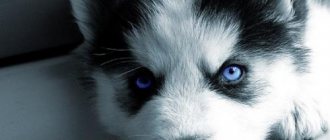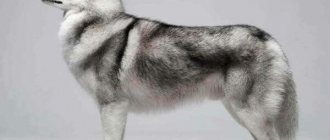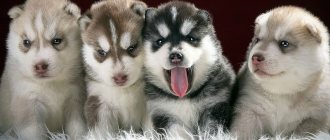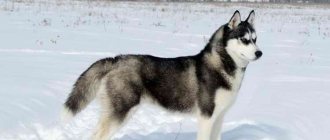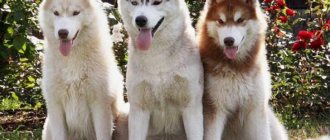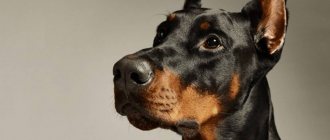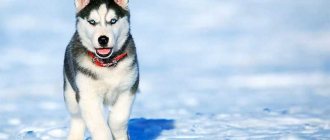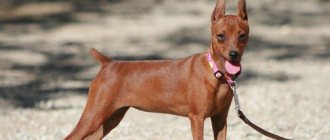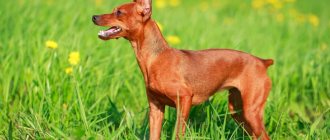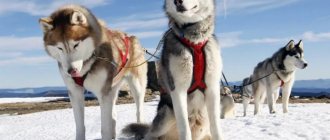Husky is one of the most popular breeds. The attractive appearance of these animals leaves virtually no chance for competitors. However, in addition to the “original” dog, there are a number of superficially similar varieties. Many of them are very popular among dog lovers, others are less known. There are also representatives of canines that few people have heard of. What is remarkable about dogs that look like huskies? And can dogs like huskies be considered related to the “original”.
Husky is one of the most beautiful dogs in the world
Malamute
You can tell a malamute from a husky simply by their looks: the former look good-natured, while the latter are more reminiscent of mischievous foxes. The main difference is the eye color. If Huskies are usually blue, then Malamutes are always brown. Malamutes are denser in build and hardy. Their fur is darker and coarser. The tail is usually raised and slightly curled. Malamutes are slower, more reserved and calm, so they cause fewer problems, but they also need to be dealt with and allowed to splash out their energy.
Malamute is rather a cross between a wolf and a bear.
Wolfdog of Saarloos
The ancestors of the Saarloos wolfdog are German shepherds and wolves. This is an unusually intelligent companion that becomes strongly attached to its owners. However, high intelligence can also be considered a disadvantage: these dogs can try to dominate their owners, so they are not suitable for beginners. Due to their independence, representatives of the breeds are often used as rescuers and guide dogs.
An interesting feature: Saarloos dogs cannot bark, they only howl like wolves
How to choose a puppy
The character and individual characteristics of the breed appear at 4 months of age. It is at this time that it is recommended to buy pets.
It is almost impossible to choose the best puppy, as they change as they grow. If the goal is to buy a husky to participate in exhibitions, only experienced dog breeders can help in choosing.
Advantages of buying a Husky puppy and care details:
- the baby will easily adapt to the lifestyle of his owners;
- increased attention to yourself will allow you to better know his inner world;
- Husky puppies quickly learn the rules of behavior;
- Babies require increased attention and you need to spend a lot of time playing with them.
If you buy an adult dog, then this moment has its advantages:
- established character;
- trained in rules of conduct;
- surprises in terms of interior damage are excluded.
The cost of puppies depends on how purebred the husky is. Purchasing purposes also influence the price.
- Pet - class is not suitable for participation in exhibitions, but will be a good friend. Such dogs are sold without a pedigree and have some distinctive characteristics from the breed standard. Puppies cost from 20,000 rubles.
- Breed class puppies are sold with good pedigree and fully comply with the standard. The price starts from 30,000 rubles.
- Show class is the most expensive. The starting price for show-class huskies is 50,000 rubles. Puppies have high characteristics, both in appearance and in the achievements of their parents. The sale of such puppies begins at 6 months of age; only during this period can the dog’s compliance with all standards be fully confirmed.
In any case, no matter what class of puppy you buy, he will turn out to be a good friend and companion with whom you are not afraid to go on a trip.
Alaskan Klee Kai
These dogs are often called a miniature version of a husky. In fact, this is so: the ancestor of the family was, presumably, a husky with the dwarfism gene, which they decided to fix. However, there is controversy over the nature of the dogs. Most owners claim that the Alaskan Klee Kai is a more balanced and calm breed. These pets also do not tolerate loneliness very well, but are less prone to running away and destructive behavior. Unfortunately, this is a rare breed, so the average cost of puppies is 100,000–150,000 rubles.
Representatives of the breed have a cute habit of washing themselves with their paws, just like cats do.
Larger breeds
Greenland dog
It is distinguished by an excellent sense of smell, strength, endurance, stamina, unpretentiousness and the ability to navigate the terrain well.
The head is similar in shape and size to a wolf: the skull is wide and slightly convex, the muzzle is short and moderately wide, slightly tapering towards the nose. The ears are triangular, small in size, erect. The eyes are dark, slightly slanted.
The body is strong and muscular, the neck is quite short and powerful, the chest is wide and voluminous. Limbs are strong, parallel and straight. The tail is thick and fluffy, relatively short, usually carried over the back.
The wool is two-layered, very thick and harsh. Any color of a Greenland dog is acceptable, except for albinism.
IMPORTANT!
Outwardly, these dogs are similar to huskies, but they are larger and stockier - their height should be at least 60 cm for males and 55 cm for females.
By nature, Greenland dogs are quite temperamental and friendly towards people, although they can be overly self-sufficient and independent. They do not recognize every person as an owner, but only the one who can achieve their respect.
Akita Inu
A large, Spitz-like dog used as a hunting and guard dog. The height at the withers is from 61 to 67 cm, and the weight is 40-50 kg.
This is a strong and robust animal with a harmonious physique. The head is quite large and heavy, but at the same time proportional to the body, the transition to a short muzzle is well defined. The eyes are small and triangular. The ears are medium-sized, erect and very dense. The body is muscular and strong, slightly stretched in length.
The Akita Inu coat . It consists of elongated and rather coarse hairs of the top layer, a hard but somewhat shorter awn and a soft dense undercoat. The most common colors are red, brindle, sesame or pure white.
Akita Inu is devoted to its owner and, if properly raised, is not aggressive. It is believed that her character contains feline traits, such as some detachment, as well as the habit of washing herself with her paws.
They are similar to huskies not only in appearance: both of these dogs are quite independent and independent, in addition, they both have hunting instincts.
American Akita
The American Akita is a fairly large dog (61-71 cm at the withers), with strong and even heavy bones, a massive head and a moderately wide muzzle. The ears are small, erect, the eyes are medium-sized, dark brown.
The body format is slightly stretched, the chest is voluminous and powerful, the back is straight, the limbs are parallel and strong. The tail is fluffy, usually curled into a complete or incomplete ring.
The coat is double, consisting of a soft and relatively short undercoat, as well as a thick and harsh elongated awn. Oh beauty can be anything.
The character is balanced and calm. These are friendly, but at the same time careful and vigilant dogs.
NOTE!
American Akitas resemble Siberian Huskies not only with erect triangular ears and a wedge-shaped head, but also with endurance, unpretentiousness and independent disposition.
Czechoslovakian Wolfdog
The Czechoslovakian Wolfdog is another cross between a German Shepherd and a wolf. Another name for the breed is wolfdog. Color varies from gray to reddish. Externally, representatives of the breed really resemble wolves. The owners note that these are very loyal and friendly dogs, but they need proper socialization. Otherwise, “wild” habits take over.
The Czechoslovakian Wolfdog appeared relatively recently - the breed was recognized by the FCI in 1999
Breeds with external similarities
Malamute
This is just like the husky, a sled dog of the aboriginal type, only larger. This breed was intended for carrying heavy loads and is one of the oldest.
Outwardly, Malamutes resemble wolves. Their sizes range from 60 to 63 cm at the withers for males and from 57 to 59 cm for females. Weight, depending on gender, can be from 34 to 40 kg.
The body is compact and strong. The head is moderately wide, but proportional to the body, the muzzle slightly tapering towards the nose. The ears are erect, triangle-shaped, slightly rounded at the tips.
The eyes are small, dark, slightly slanted. The expression of the muzzle is intelligent, friendly and calm. The tail is carried over the back, but is not curled. The wool is two-layered, consisting of soft down and coarse guard hair.
NOTE!
The length of the coat varies from short on the head, ears, muzzle and front of the legs to longer on the back, withers, neck, rump, hips and tail.
By nature, these are friendly, calm and balanced dogs, distinguished by intelligence and intelligence. However, due to the Malamute's hunting instinct, it can be aggressive towards smaller animals and, moreover, strives to take a dominant position among other dogs.
They are similar to huskies, first of all, in their color: with a light mask on the face and lightening on the neck, chest, belly, limbs and, often, on the tail. In addition, both of these dogs have triangular ears, thick coat consisting of two layers and a fairly long, well-furred tail.
Inuit
An officially unrecognized breed of dog that looks like a wolf, which was bred using huskies, malamutes, German shepherds, and possibly other, mainly sledding breeds.
Dimensions can range from 59 to 76 cm at the withers, and weight can range from 25 to 50 kg.
The body format is close to square. The head is in the form of a wedge, the slightly elongated muzzle is equal in length to the skull. The eyes are almond-shaped, their color can be golden, amber or brown; there are also Inuit with blue eyes. The ears are erect, slightly rounded, set quite close to each other. The nose is usually black.
The physique is moderately strong and harmonious. The line of the back is slightly sloping towards the croup, the chest is deep and quite wide, the belly is slightly tucked. The tail is straight or sickle-shaped, hanging down.
The coat is thick and dense, consisting of a hard spine and soft undercoat, with slight pubescence on the tail, and a small collar or something like a small mane on the neck.
The most characteristic colors of the Inuit are pure white, pure black and grayish wolf, and often there is a lightish mask on the muzzle, giving these dogs a resemblance to a husky.
Their character is not simple: they, like huskies, are characterized by stubbornness and self-will. In addition, Inuit are dominant towards other dogs and can be overly distrustful of strangers.
Volchak
Brought out in Czechoslovakia as a result of an experiment on crossing German shepherds and Carpathian wolves conducted in 1955.
The physique is similar to a wolf, it is characterized by a slightly stretched body, small erect ears and a slightly flattened, but at the same time deep chest. The forelimbs are level and straight, spaced rather narrowly. The tail is set low, and when calm it hangs down and reaches the metatarsus.
Height is at least 65 cm, and weight is from 20 kg.
IMPORTANT!
A characteristic feature of this breed, which gives it a special resemblance to wolves, is thick, but not particularly long, zone-gray or grayish-yellow hair.
Wolfdogs are distinguished by their temperamental, rather active and playful disposition. But due to the presence of the blood of a wild predator, they are aggressive towards other animals.
Wolf dogs are similar to huskies with triangular ears, a wedge-shaped head with a slightly narrowed muzzle, and thick and dense hair.
Wolfdog
This hybrid, like the wolfdog, appeared as a result of targeted interspecific crossing of a wolf and a German shepherd. But the wolf-dog has a significantly higher percentage of the blood of a wild predator, which determines not only its more obvious external resemblance to a wolf, but also its mental and temperamental characteristics.
They have a keen sense of smell and excellent learning ability and are quite tolerant of strangers.
These are large animals, similar to both wolves and German shepherds. They also somewhat resemble Siberian huskies with erect triangular ears and their predominantly grayish coloring.
Wolf dogs are not recognized by any cynological federation in the world.
Klee Kai
The Klee Kai is a dog breed very similar to the Husky, but differs from them in being much smaller in stature. Their height at the withers does not exceed 43 cm, and their weight is 11 kg.
The muzzle is somewhat shorter than that of a husky, the ears are larger, and the tail is set higher. Klee Kais come in only three coat colors: black and white, gray and white, and red and white. Their fur itself can be either quite short or relatively long.
There are many similarities in the character of Klee Kais and Huskies: they are equally intelligent, curious and active. But Klee Kais do not have the good nature of huskies towards strangers: they are distrustful and quite cautious.
They also have another similarity with huskies - the eyes of Klee Kais can be not only brown, but also blue.
Klee Kais have a hunting instinct, which is why they need proper and timely socialization.
Shiba Inu
Despite the fact that the Shiba Inu is not a sled dog, but an Asian-type Spitz, it resembles a husky with thick double-layered hair, triangular erect ears and an upturned tail. True, the Shiba Inu is smaller size
They are characterized by the so-called urajiro - lightening of the main color to almost white on the face, neck, chest, belly, paws and the inside of the tail. Essentially, this is a variation of the subclass typical of Siberian Huskies.
Like Siberian Huskies, Shiba Inus are very smart and quick-witted, they are also characterized by stubbornness and independence. However, they are more calm, obedient and sincere.
NOTE!
The Shiba Inu has long been used as a hunting breed, and therefore can be aggressive towards birds and rodents, which it considers its prey.
Laika
Laikas are dogs that belong to a group of breeds that have similar appearance, behavioral characteristics and character. Most huskies are considered universal hunting dogs, which, however, can also perform other functions, such as guarding the house.
By nature, they are distinguished by a calm and balanced temperament, obedient and devoted to their owners. When hunting, they are tireless, hardy and excellent at untangling animal tracks.
The external features of huskies that give them a resemblance to a husky include a rather compact build, erect triangular ears, as well as dense and thick, but not particularly long, hair.
The husky's tail is usually curled into a ring, thanks to which it can be easily distinguished from a husky.
Samoyed
The Samoyed is a medium-sized, fluffy white dog with a harmonious build and elegant appearance. In her entire appearance one can feel strength, power and endurance, combined with friendliness and charm.
The Samoyed's ears are small, erect, and triangular in shape; when moving, the tail can be thrown over the back or side, and when calm it can be lowered and touch the hocks.
The coat is very thick and fluffy, forming a kind of collar on the neck, as well as pants on the hind legs and hair on the tail, giving it the appearance of a plume.
The Samoyed's coat must have the cool, sparkling shine characteristic of this breed.
They are friendly, playful and smart in nature. Like Siberian Huskies, they have a willful and independent disposition, as well as a tendency to be stubborn at times.
However, both the Husky and the Samoyed have many positive traits: both of these dogs are strong, hardy, unpretentious, love children and are devoted to their owners.
Samoyed husky
The Samoyed husky looks less like a husky, but it looks like a snow-white wolf. Most representatives of the breed boast a fluffy white coat. However, it requires intensive care, otherwise the fur may become tangled. These are beautiful dogs, but they are not suitable for beginners due to their stubborn and capricious nature.
Cream spots, cream coloring and freckles on the nose are acceptable in the color of the Samoyed dog, and the first four generations of breeding of these dogs were completely black
Story
The emergence of such a mini version of the famous huskies is justified by the fact that now everyone who wants to become the owner of this positive pet in every sense will be able to choose a suitable option for themselves.
This is the story of not only one breed, but also one person’s dream. She will tell us that if you really want something and are ready to act, work and experiment to achieve your goal, then success is guaranteed.
American breeder Linda Spurling has been creating a new, smaller breed of husky since 1970. This decision arose completely by chance. While visiting a friend in another state, Linda saw her pet, exactly like a husky, but only small. She was so impressed and surprised by the smaller copy of her favorite breed that she managed to persuade her friend to give her the dog. Returning home, Spurling began looking for other Lilliputian representatives of the huskies.
The selection was carried out in the most thorough manner; a real search was carried out throughout Alaska (where the breeder lived). Siberian and Alaskan huskies, several varieties of huskies took part in the mating, and an American Eskimo dog of the Toy class was used for reduction. Thus, there was no need to interfere with dwarfism in the process, the reduction in the size of the dog occurred naturally.
And then events developed naturally. The result exceeded all expectations and, every time she walked with her pets, the breeder certainly drew attention to herself and her charges from passers-by.
One day she received a call from a well-known journalist who said that these dogs are needed by people, humanity needs them and assured Linda of her support and provision of all possible assistance. An entire article was published about the amazing pets, after which interest in the breeder literally skyrocketed. Everyone wanted to meet the kids, admire them and even acquire such a four-legged friend for themselves.
Linda was overcome by doubts, she was not sure that the result of her work was satisfactory and that she was ready to present it to the world. The breeder was prompted to take decisive action by the fact that the number of her charges had already exceeded the number of thirty, and yet they needed to be maintained, fed and given their time.
was announced . After this, Linda's quiet life ended. The phone rang all day in her house, she constantly received visitors, and everyone left deliriously happy with a little furball, a unique creature created with the love of one person.
Spurling treated her creations with great care and interviewed potential buyers before making a sale. In order not to ruin the idea by allowing everyone to conduct similar experiments without following the basic rules, Linda did everything necessary to ensure strict control of breed characteristics.
Through her efforts, breed standards were created and legalized, after which a breed club immediately emerged. In 1997, mini huskies received official worldwide recognition and were included in the registry under the name Alaskan Klee Kai.
Tamaskan dog
The Tamaskan dog was developed in Finland. It is the result of crossing a Malamute, a Husky and a German Shepherd. The result is family companions that enjoy playing with other pets and children, but look like real wolves. These pets can be very large: weight reaches 40–45 kg.
They need constant physical activity and long walks.
Utonagan
This breed of dog is also a little similar to a husky, only it differs in the presence of red and brown shades. The Utonagan is 60-72 cm tall, weighs 26-50 kg, and is a cross between a Siberian Husky, a German Shepherd and an Alaskan Malamute. The dogs have a good undercoat and are very hardy. Their coat is quite colorful, combining white, light brown and dark brown shades.
Utonagans are perfect for living in an apartment as a companion dog, and for guarding a country house . This breed has a very good appetite, so the owner must carefully monitor the amount of food the pet consumes.
Dear readers, did you know what dog breeds are similar in appearance to huskies? Are there any owners of any of the above breeds among you? Tell us about your experience of keeping such pets. Would you like to have one of these cute dogs and who exactly?
Northern Inuit
The Northern Inuit is a breed that is still not recognized by the FCI. Outwardly, it is a cross between a Samoyed husky, a husky and a wolf. There are even Inuit with a white coat. Unlike Samoyeds, they look less plush.
Northern Inuit dogs played direwolves in the Game of Thrones series, based on the A Song of Ice and Fire book series by George R. R. Martin
